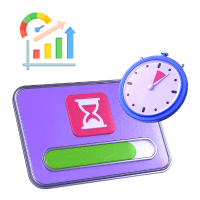
What is full time equivalent, or FTE for short? How to calculate it? Why does it matter to your business? If all these questions are also guests in your mind, then no need to be overwhelmed. Whether you are a new business owner, an experienced one, or about to start it soon, one thing is for sure is that you know that everything revolves around your human resources and their time in which they could have spent doing something more useful, which they offer up for your lame work.
That’s where calculating FTE is essential. Remember, regardless of the sector in which you do business, it is vital to stay updated on the number of employees and the hours they work. Simply put, full time equivalent is one of the metrics that assists you in determining that.
So, in today’s blog, we will cover what it is, why it is essential, practical applications, how to calculate FTE, and some more useful insights. With that out of our way, let’s get right into it.
What is Full Time Equivalent?
Full time equivalent is a tool to assist you in benchmarking your business’s potential productivity. Its overall usage is to determine the total full-time hours that your team or organization can or has performed during a specific time. Moreover, here are a few more aspects to stay updated with:
- A full-time employee represents an FTE of 1. On the other hand, part-time laborers have 0.5 FTE.
- It allows businesses to evaluate workforce capacity and their teams’, team members’, departments’, or business’s real performances.
Read Also: Average Salary in Japan in 2025: The Complete Insights
Full Time Equivalent in Various Sectors

By knowing what is FTE and how to calculate it, organizations in multiple sectors, such as yours, can make data-driven decisions, supporting operational efficiency and legal compliance. For instance:
- Healthcare can use it to identify the number of doctors and nurses required to offer quality patient care while staying within budget.
- A university or other educational institution can use the metric to identify the staffing needs for a specific semester’s courses.
How to Calculate Full Time Equivalent?

FTE calculation is not that hard or complicated. You just need to follow these 6 easy, tried, tested, and proven steps. However, please note that the minimum values we have taken are for the standard 40 hours per week, so if you have set another minimum, just adjust accordingly, and you are good to go:
1. List Your Employees
The first one is obvious. All you have to do is make a list of your employees along with their total work hours. Don’t forget to include their paid and unpaid leaves in the total time for more accuracy. After going through this trouble, you should have a list like this.
| Employee Name | Total Work Hours for a Week |
| That One Guy Who Always Comes Late | 40 |
| The Daydreamer | 38 |
| The Encyclopedia | 28 |
| The One Who Gets All the Blame | 12 |
| The One With All the Excuses | 35 |
2. Full-Time Vs. Part-Time Employees
The next step in calculating FTE is to categorize your workforce into full-time and part-time workers. Usually, all employees who have worked for between 30 and 40 hours will be considered for full-time or an FTE of 1. What you need to do is add a third column to your list for this category. In our case:
| Employee Name | Total Work Hours for a Week | Employment Category |
| That One Guy Who Always Comes Late | 40 | Full-time |
| The Daydreamer | 38 | Full-time |
| The Encyclopedia | 28 | Part-time |
| The One Who Gets All the Blame | 12 | Part-time |
| The One With All the Excuses | 35 | Full-time |
3. Sum Up All the Work Hours
Now, for your full time equivalent, you need to separately add the work hours of your full and part-time workers. Here’s what we have so far:
- Full-time workers: 40 + 38 + 35 = 113
- Part-time staff: 28 + 12 = 40
4. Identify Total Hours Per Week
The next thing you need to do is add up the total number of work hours for the week. This includes all the work hours of all your employees. If you have done everything right so far, you should get:
- Full workers + part teams: 113 + 40 = 153
5. Calculate the Ideal FTE
The next step involves calculating the ideal metric for your full time equivalent. What we need here is to assume that all your employees work the same employment-based hours per week. In this case, the part-time workers work 20 hours, and the full-time individuals work 40 hours weekly. For example:
- Weekly work-time for 3 full-time employees is 120 (40 * 3). The FTE here is 1 for a staff member. So, for 3 workers, it’s 3.
- The same for 2 part-time employees is 40 (20 * 2). The FTE here is 0.5 for an employee. So for 2 individuals, it’s 1.
- Now, our IFTE = 3 + 1 = 4. That is 160 hours. You get this metric by dividing the total work hours by the regular weekly work hours. I.e., 160 / 40 = 4.
6. Calculate Your FTE
Now, for calculating the actual FTE, you need a few formulas:
- Weekly = 153 / 40 = 3.825.
- Monthly = Total work hours * number of weeks in a month = 153 * 4 = 612. Next, you need to multiply the optimal time of one full-time laborer by the number of weeks in a month. I.e., 40 * 4 = 160. Finally, divide the 2 values: 612 / 160 = 3.825.
- Yearly = Complete work hours per week * total weeks in a year = 153 * 52 = 7956. For one worker, this value will be 40 * 52 = 2080. Don’t forget to divide the 2 values. I.e., 7956 / 2080 = 3.8 FTE.
We can notice here that the monthly and weekly metrics are the same. However, in real life, this won’t be the case as the total number of hours per week will be different.
Read Also: Compliance Management System Software: A Complete Guide
Benefits of Full Time Equivalent for Your Business

Now, you must be wondering, why go through all the trouble of calculating the full time equivalent in your enterprise? The process is complicated. However, it’s rewarding. The benefits include:
1. Greater Performance Review
The metric provides you with a bigger picture of how your employees are doing professionally. Instead of just concentrating on how many human resources you have, you will get insights into how many hours they have worked. Overall, it provides you with your business’s combined performance capabilities.
2. Easy to Plan New Projects
Planning new projects and estimating costs can be a real pain. Especially if you have employees with different contract types, let’s say full-time, part-time, and freelancers working for you. However, when you have the FTE, assigning the right human resources to the right tasks, based on their overall performance and contributions, becomes simpler.
3. Compliance Assurance
The Affordable Care Act (ACA) and the Applicable Large Employers (ALE) state that you need to:
- Provide certain workers and their dependents with a particular type of healthcare coverage.
- Make reports on the minimum healthcare insurance to both employees and the IRS.
Based on your FTE in Workday, some of your employees can be eligible for affordable healthcare insurance. What this does is let you stay compliant with state and federal laws. You must know that under the ACA, any employee who works 30 hours weekly or 130 hours monthly at a minimum is entitled to some form of healthcare.
4. Better Costs & Budget Control
The full time equivalent value is crucial for determining the labor expenses incurred. The value assists you in planning your payroll expense management. As a bonus, you can be sure to never be understaffed or overstaffed.
Read Also:
Why is Full Time Equivalent Essential for HR Management?
Make your workday more productive
Time tracking and work management can help you reach your goals
faster.
From headcount optimization and labor cost management to employment law compliance assurance, promotions, dismissals, and training programs, knowing how to calculate FTE makes data-driven decision-making much simpler. Plus, it also helps you:
- To see if your business’s productivity is positively affected by the increased number of part-time employees.
- To identify the total productivity based on the real working hours of your staff.
- To plan upcoming projects and the total number of full and part-time human resources you need to schedule for these tasks.
Practical Applications of Full Time Equivalent for Your Business
There are various contexts where your HR professionals can implement full time equivalent calculations, including:
- Salary Determination: To determine fair salaries for part-time employees.
- Resource Allocation: To effectively plan and distribute resources throughout projects.
- Performance Analysis: To evaluate team productivity and streamline workforce distribution.
How DeskTrack Makes Calculating FTE Simple
With DeskTrack’s time tracking software, calculating full time equivalent becomes so simple that you won’t believe it. No matter how much your employees work per day, it automatically tracks and logs the accurate work-time in real-time. You get various categories, such as productive, unproductive, and total time, with time deviations, with detailed insights, data analysis, and reports, that not only give you how much your employees worked for the week, but also their work-time utilization efficiency levels.
Frequently Asked Questions (FAQ)
Q. What is Full Time Equivalent?
Ans. Full time equivalent is a tool to assist you in benchmarking your business’s potential productivity. Its overall usage is to determine the total full-time hours that your team or organization can or has performed during a specific time.
Q. How to Calculate FTE?
Ans. Here are the 6 easy steps you need:
- List Your Employees
- Full-Time Vs. Part-Time Employees
- Sum Up All the Work Hours
- Identify Total Hours Per Week
- Calculate the Ideal FTE
- Calculate Your FTE
Q. What are the Benefits of Full Time Equivalent for Your Business?
Ans. Here’s why you need to calculate FTE:
- Greater Performance Review
- Easy to Plan New Projects
- Compliance Assurance
- Better Costs & Budget Control
Q. Why is FTE Essential for HR Management?
Ans. The metric helps your HR professionals:
- To see if your business’s productivity is positively affected by the increased number of part-time employees.
- To identify the total productivity based on the real working hours of your staff.
- To plan upcoming projects and the total number of full and part-time human resources you need to schedule for these tasks.
Q. What are the Applications of Calculating FTE for Your Business?
Ans. Here’s why it is crucial for your business, including:
- To determine fair salaries for part-time employees.
- To evaluate team productivity and streamline workforce distribution.










